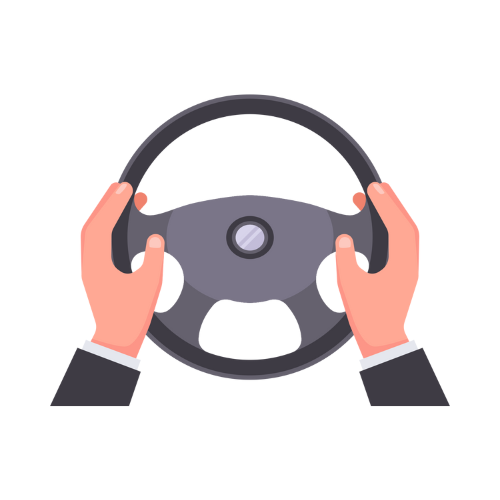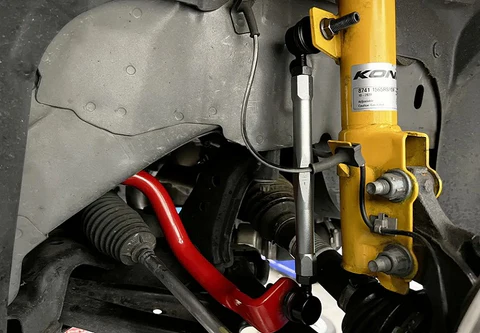Can Bad Sway Bar Links Lead to Shaky Control?
Yes, bad sway bar links can cause steering wheel vibration. When the links are worn or damaged, they can create excessive movement in the sway bar, leading to steering wheel vibration.
This can impact the vehicle’s handling and stability, potentially causing safety concerns. It’s important to address any issues with sway bar links promptly to maintain safe driving conditions. In this blog post, we’ll explore the signs of bad sway bar links, the potential impact on steering wheel vibration, and the importance of addressing these issues for optimal vehicle performance and safety.
We’ll also discuss how to diagnose and fix sway bar link problems to ensure a smooth and stable driving experience.
Introduction To Sway Bar Links

Sway bar links can lead to steering wheel vibrations if they are worn out or damaged. The links connect the sway bar to the control arms, affecting stability and smooth steering. Regular inspection and maintenance can prevent this issue.
The Role In Vehicle Stability
Sway bar links connect the suspension to help control body roll.
Symptoms Of Faulty Links
Vibration in the steering wheel indicates potential issues.
Analyzing Sway Bar Link Failures
Sway bar links, also known as stabilizer links, are an integral component of a vehicle’s suspension system. They connect the sway bar to the suspension, helping to reduce body roll during cornering and improving stability.
When these links fail, they can have a significant impact on the vehicle’s handling and ride quality. In this section, we will analyze sway bar link failures, including the common causes of wear and tear and the impact on driving dynamics.
Common Causes Of Wear And Tear
Like any mechanical component, sway bar links are subject to wear and tear over time. The most common causes of wear and tear include:
- Exposure to the elements: Sway bar links are exposed to the elements, including moisture, road salt, and debris. Over time, this exposure can cause rust and corrosion, leading to failure.
- Driving conditions: Driving on rough roads or over potholes can put additional stress on the suspension system, including the sway bar links.
- Age: As with any component, sway bar links will eventually wear out over time due to age and use.
The Impact On Driving Dynamics
When sway bar links fail, they can have a significant impact on a vehicle’s driving dynamics.
The most common symptoms of a failed sway bar link include:
- Steering wheel vibration: If the sway bar link has excessive play or is broken, it can cause the steering wheel to vibrate while driving.
- Noise: A failed sway bar link can also cause clunking or rattling noises while driving over bumps or rough roads.
- Poor handling: A vehicle with a failed sway bar link may experience increased body roll during cornering, making it more difficult to control.
- Tire wear: A failed sway bar link can also cause uneven tire wear due to the vehicle’s poor handling.
It is important to address any issues with sway bar links as soon as possible to ensure the safety and performance of your vehicle. Regular inspections and maintenance can help prevent sway bar link failures and keep your vehicle’s suspension system in top condition.
Consequences Of Neglecting Bad Sway Bar Links
Bad sway bar links can have significant consequences if neglected. The sway bar, also known as the stabilizer bar, plays a crucial role in maintaining stability and control during cornering and uneven road conditions. When the sway bar links go bad, it can lead to various issues that affect the overall performance and safety of the vehicle.
Reduced Cornering Performance
Bad sway bar links can result in reduced cornering performance. This can cause the vehicle to feel less stable when navigating turns, leading to a potential loss of control. As a result, the overall driving experience may become less predictable and more hazardous.
Potential For Uneven Tire Wear
Neglecting bad sway bar links may lead to uneven tire wear. When the sway bar links are not functioning properly, it can impact the distribution of weight and pressure on the tires. This uneven distribution can cause certain tires to wear out faster than others, leading to the need for premature replacement and increased maintenance costs.
Sway Bar Links And Shaky Control
When it comes to ensuring a smooth and stable ride, the sway bar links play a crucial role in maintaining control over your vehicle. These small yet significant components connect the suspension system to the chassis, helping to distribute weight evenly and reduce body roll during turns.
However, when these sway bar links become worn or damaged, they can compromise the stability of your vehicle, leading to steering wheel vibrations and a shaky driving experience.
How Stability Is Compromised
Sway bar links are designed to keep your vehicle stable by transferring the force of the suspension movement from one side to the other. When these links wear out or become loose, they fail to perform their function effectively, resulting in an imbalance in weight distribution.
This imbalance can lead to uneven tire wear, reduced traction, and ultimately, a vibrating steering wheel.
Real-world Scenarios
Imagine driving down the road and feeling your steering wheel vibrate uncontrollably. This can be a disconcerting experience, especially when it affects your ability to maintain a straight line on the road. Bad sway bar links can cause these vibrations, making it challenging to drive smoothly and safely.
Real-world scenarios where bad sway bar links can cause steering wheel vibration include:
- Driving on uneven or bumpy roads: The worn or damaged sway bar links may exacerbate the impact of road imperfections, leading to increased vibrations felt through the steering wheel.
- Taking sharp turns: When navigating sharp turns, the sway bar links are crucial in maintaining stability. If they are faulty, the vehicle’s body roll increases, resulting in vibrations that can be felt in the steering wheel.
- Accelerating or decelerating: As you accelerate or decelerate, the weight distribution of the vehicle changes. If the sway bar links are worn or damaged, this change in weight distribution can cause vibrations in the steering wheel.
It’s important to address any issues with your sway bar links promptly to ensure a safe and comfortable driving experience. Regular inspections and maintenance can help prevent steering wheel vibrations caused by bad sway bar links, allowing you to enjoy a smooth and controlled ride on the road.
Diagnosing Sway Bar Link Issues
Experiencing steering wheel vibration? Faulty sway bar links could be the culprit. Diagnosing sway bar link issues is crucial to ensure safe and smooth driving.
If you’ve been experiencing a steering wheel vibration while driving, one possible cause could be faulty sway bar links. The sway bar, also known as the stabilizer bar, plays a crucial role in maintaining stability and reducing body roll during cornering.
However, over time, the sway bar links can wear out or become damaged, leading to issues such as steering wheel vibrations.
Visual Inspection Tips
Performing a visual inspection is the first step in diagnosing sway bar link issues.
Here are some tips to help you identify potential problems:
- Inspect the sway bar links for any signs of physical damage, such as cracks, tears, or missing parts.
- Check for excessive play or looseness in the sway bar links. They should be securely attached without any noticeable movement.
- Look for signs of rust or corrosion on the sway bar links, as this can weaken their structural integrity.
- Ensure that the sway bar links are properly aligned and not bent or twisted.
Auditory Cues To Listen For
In addition to a visual inspection, listening for certain auditory cues can also help in diagnosing sway bar link issues. Here are some sounds that may indicate problems with the sway bar links:
- Clunking or knocking noises when driving over bumps or uneven surfaces.
- Squeaking or creaking sounds during turns or when the suspension is compressed.
- Rattling or metallic noises when driving at higher speeds or on rough roads.
If you notice any of these signs during your visual inspection or while listening for auditory cues, it is likely that your sway bar links are worn out or damaged. It is recommended to have them inspected and replaced by a qualified mechanic to ensure your vehicle’s safety and smooth driving experience.
Repairing Or Replacing Sway Bar Links
Bad sway bar links can cause steering wheel vibration. Repairing or replacing the sway bar links can resolve this issue and improve the overall stability and handling of the vehicle. It is essential to address this problem promptly to ensure a safe and smooth driving experience.
When To Opt For Repair
If your vehicle exhibits a slight steering wheel vibration or rattling noise when driving over bumps, it may be time to consider repairing the sway bar links. Regular inspection and maintenance can help catch issues early on. If the sway bar links show signs of wear, such as looseness or play, opting for a repair might be the most cost-effective solution. Professional assessment is crucial to determine if a repair is feasible.
Guidelines For Replacement
When the sway bar links are severely worn, damaged, or broken, replacement becomes necessary. It’s important to replace both sides to maintain balance and stability. Opt for high-quality aftermarket or OEM sway bar links to ensure longevity and performance. Professional installation is recommended to ensure proper alignment and function.
The Cost-benefit Analysis
When considering the impact of bad sway bar links on steering wheel vibration, a crucial factor to weigh is the cost-benefit analysis. Evaluating repair costs and long-term savings plays a key role in making an informed decision.
Evaluating Repair Costs
Repair costs for fixing bad sway bar links causing steering wheel vibration can range from $100 to $250. Factor in labor costs if not doing it yourself.
Long-term Savings
Replacing faulty sway bar links can prevent further damage to the suspension system, potentially saving hundreds in future repairs.
Preventative Measures
Bad sway bar links can indeed cause steering wheel vibration, making it essential to take preventative measures. By regularly inspecting and replacing worn-out sway bar links, drivers can ensure a smoother and safer driving experience, reducing the risk of steering wheel vibrations and potential accidents.
Routine Maintenance Tips
Regularly inspect sway bar links for wear and tear.
Check for loose or damaged components and replace as needed.
Upgrading To High-performance Links
Consider upgrading to sturdier materials for increased durability.
Opt for high-quality aftermarket sway bar links for better performance.
Conclusion
Based on the information presented in this blog post, it is clear that bad sway bar links can indeed cause steering wheel vibration. It is important to regularly inspect and maintain your vehicle’s suspension system to prevent issues like this from occurring.
Don’t ignore any signs of vibration or unusual handling, as they could indicate a serious problem with your vehicle’s safety. By taking proactive measures to address any issues, you can ensure a safer and smoother driving experience.

Specializes on car underchassis & power steering repair. We have experienced mechanic to attend all your underchassis & power steering repair needs.



